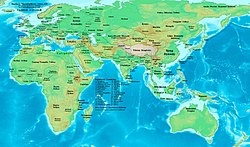Salghurids
Salghurids سلغُریان | |||||||||
|---|---|---|---|---|---|---|---|---|---|
| 1148–1282 | |||||||||
 | |||||||||
| Status | Atabegate | ||||||||
| Capital | Shiraz | ||||||||
| Common languages | Persian Turkic | ||||||||
| Religion | Sunni Islam | ||||||||
| Government | Monarchy | ||||||||
| Atabeg | |||||||||
• 1148–1161 | Sunqur ibn Mawdud | ||||||||
• 1264–1282 | Abish Khatun | ||||||||
| Historical era | Middle Ages | ||||||||
• Established | 1148 | ||||||||
• Disestablished | 1282 | ||||||||
| |||||||||
| History of Iran |
|---|
 |
|
Timeline |
| History of the Turkic peoples pre–14th century |
|---|
 |
| Tiele people |
| Göktürks |
(Tokhara Yabghus, Turk Shahis)
|
| Khazar Khaganate 618–1048 |
| Xueyantuo 628–646 |
| Kangar union 659–750 |
| Turk Shahi 665-850 |
| Türgesh Khaganate 699–766 |
| Kimek confederation 743–1035 |
| Uyghur Khaganate 744–840 |
| Oghuz Yabgu State 750–1055 |
| Karluk Yabgu State 756–940 |
| Kara-Khanid Khanate 840–1212 |
|
| Ganzhou Uyghur Kingdom 848–1036 |
| Qocho 856–1335 |
| Pecheneg Khanates 860–1091 |
| Ghaznavid Empire 963–1186 |
| Seljuk Empire 1037–1194 |
| Cuman–Kipchak confederation 1067–1239 |
| Khwarazmian Empire 1077–1231 |
| Kerait Khanate 11th century–13th century |
| Delhi Sultanate 1206–1526 |
| Qarlughid Kingdom 1224–1266 |
| Golden Horde 1240s–1502 |
| Mamluk Sultanate (Cairo) 1250–1517 |
The Salghurids (Persian: سلغُریان), also known as the Atabegs of Fars (اتابکان فارس), were a dynasty of Salur[1] Turkmen origin[2] that ruled Fars, first as vassals of the Seljuqs then for the Khwarazm Shahs in the 13th century. The Salghurids were established by Sunqur in 1148, who had profited from the rebellions during the reign of Seljuq sultan Mas'ud ibn Muhammad. Later the Salghurids were able to solidify their position in southern Persia to the point of campaigning against Kurds and involving themselves in the succession of the Kirman Seljuqs,[3] holding Seljuq sultan Malik-Shah III's son Mahmud as a possible claimant to the Seljuq throne.[4] They briefly occupied Isfahan in 1203-4,[2] and later occupied Bahrain taken from the Uyunid dynasty in 1235.[5]
Under Sa'd I ibn Zangi, the Salghurids experienced a significant prosperity, which was marred by his acknowledging the Khwarazm Shahs as his overlord. Saadi Shirazi, the Persian poet, dedicated his Bostan and Gulistan to Sa'd I and Sa'd II.[3] Following Sa'd I's death, his brother Zangi ibn Mawdud took power in 1161. Tekele followed his father, Zangi, only after eliminating Sonqur's son Toghril.[2]
During the 13th century, the Salghurids patronized a cultural and intellectual atmosphere which included, Qadi Baydawi, Qutb al-Din al-Shirazi, Saadi Shirazi and the historian Wassaf.[6]
During the closing years of Abu Bakr ibn Sa'd and Sa'd II, Fars fell under the dominion of Mongol empire and later the Ilkhanate of Hulegu. Under the Mongols, Abu Bakr was given the title of Qutlugh Khan. Later Salghurids were powerless figureheads, until the daughter of Sa'd II, Abish Khatun was given the title of Atabegate of Fars. She was the sole ruler of Fars for one year whereupon she married, Mengu Temur, eleventh son of Hulegu.[6] Following their deaths, Fars was ruled directly by the Ilkhanate.[3]
The Salghurids knowingly promoted themselves as an Iranian and Islamic dynasty, partly through their links to the ruins of the pre-Islamic Achaemenid Empire (550–330 BC).[7] Under them, Shiraz became a hub for Persian culture.[8]
List of Atabegs[]
- Sunqur ibn Mawdud (1148–1161)
- Zangi ibn Mawdud (1161–1178)
- Tekele ibn Zangi (1178–1198)
- Sa'd I ibn Zangi (1198–1226)
- Abu Bakr ibn Sa'd (1226–1260)
- Sa'd II (1260–1260)
- Muhammad I ibn Sa'd (1260–1262)
- Muhammad II ibn Salghur (1263)
- Saljuk Shah ibn Salghur (1263)
- Abish Khatun (1263–1282)
References[]
- ^ ERDOĞAN MERÇİL (1988–2016). "SALGURLULAR İran'ın Fars bölgesinde hüküm süren Türk-İslâm hânedanı (1148-1286).". TDV Encyclopedia of Islam (44+2 vols.) (in Turkish). Istanbul: Turkiye Diyanet Foundation, Centre for Islamic Studies.
- ^ a b c Bosworth 1995, p. 978.
- ^ a b c Bosworth 1996, p. 207.
- ^ Bosworth 1968, p. 169.
- ^ Curtis E. Larsen, Life and Land Use on the Bahrain Islands: The Geoarchaeology of an Ancient Society, (University of Chicago Press, 1984), 66.
- ^ a b Bosworth 1995, p. 979.
- ^ Kamola 2019, p. 69.
- ^ Darling 2013, p. 101.
Sources[]
- Bosworth, C. E. (1968). "The Political and Dynastic History of the Iranian World (A.D. 1000–1217)". In Frye, R. N. (ed.). The Cambridge History of Iran, Volume 5: The Saljuq and Mongol periods. Cambridge: Cambridge University Press. pp. 1–202. ISBN 978-0-521-06936-6.
- Bosworth, C. E. (1995). "Salg̲h̲urids". In Bosworth, C. E.; van Donzel, E.; Heinrichs, W. P. & Lecomte, G. (eds.). The Encyclopaedia of Islam, New Edition, Volume VIII: Ned–Sam. Leiden: E. J. Brill. pp. 978–979. ISBN 978-90-04-09834-3.
- Bosworth, C. E. (1996). The New Islamic Dynasties: A Chronological and Genealogical Manual. New York City: Columbia University Press. ISBN 0-231-10714-5.
- Darling, Linda T. (2013). A History of Social Justice and Political Power in the Middle East: The Circle of Justice from Mesopotamia to Globalization. Routledge. ISBN 978-0415503624.
- Durand-Guédy, David (2015). "1147: The Battle of Qara-Tegin and the Rise of Azarbayjan". Der Islam. De Gruyter. 92 (1): 161–196. doi:10.1515/islam-2015-0007.
- Kamola, Stefan (2019). Making Mongol History Rashid al-Din and the Jamiʿ al-Tawarikh. Edinburgh University Press. ISBN 978-1474421423.
- Limbert, John (2004). Shiraz in the Age of Hafez. University of Washington Press. ISBN 978-0295983912.
- Spuler, B. (1983). "Abū Bakr b. Saʿd". In Yarshater, Ehsan (ed.). Encyclopædia Iranica, Volume I/3: Ablution, Islamic–Abū Manṣūr Heravı̄. London and New York: Routledge & Kegan Paul. p. 261. ISBN 978-0-71009-092-8.
- Spuler, B. (1987). "Atābakān-e Fārs". In Yarshater, Ehsan (ed.). Encyclopædia Iranica, Volume II/8: Aśoka IV–Āṯār al-Wozarāʾ. London and New York: Routledge & Kegan Paul. pp. 894–896. ISBN 978-0-71009-108-6.
- Turkic dynasties
- History of Fars Province
- 12th century in Iran
- 13th century in Iran
- Atabegs
- Salur tribe